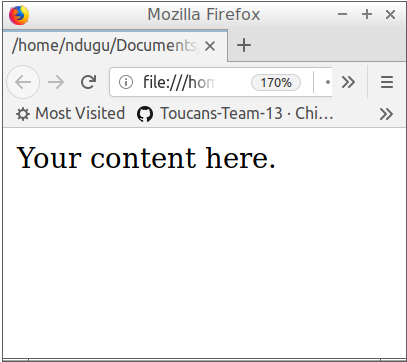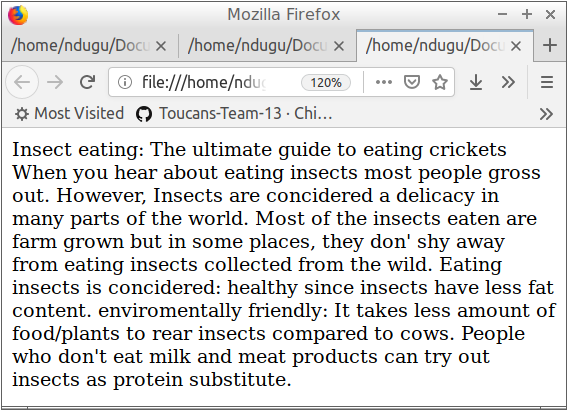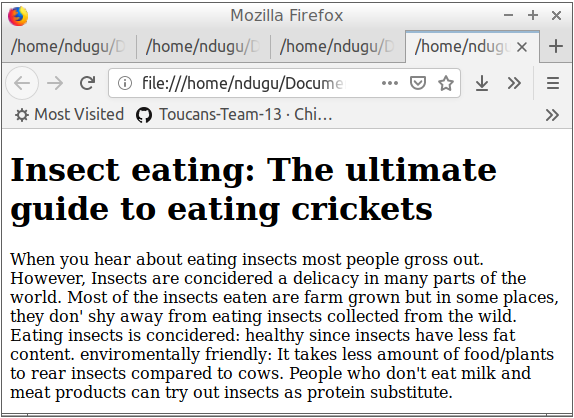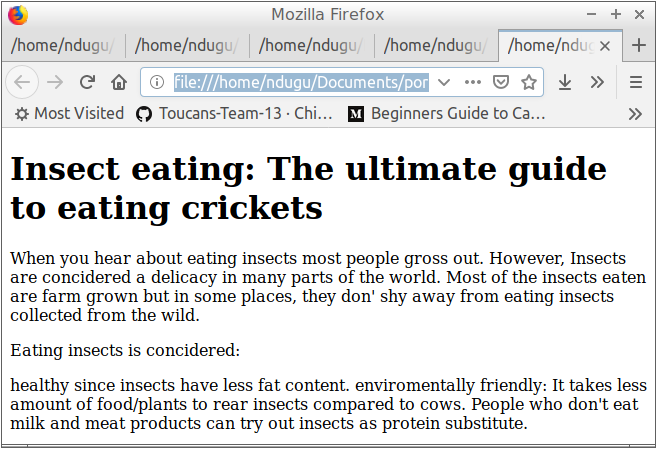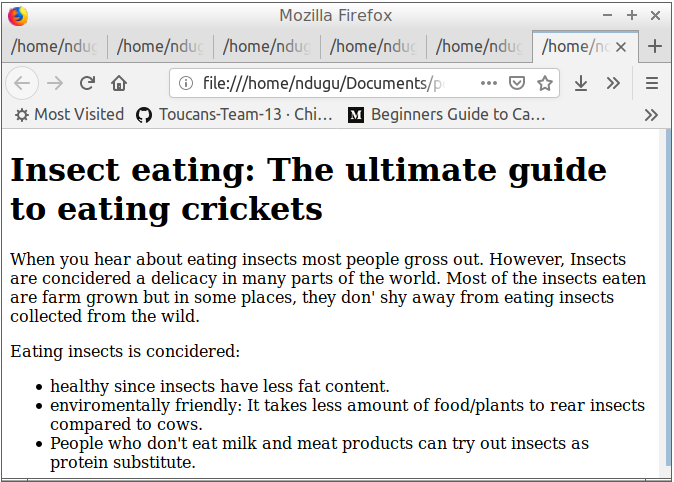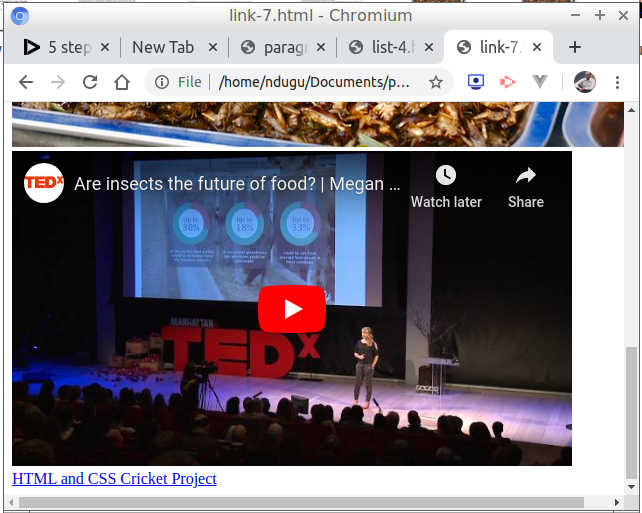- 9 Steps to Create a Web Page using Basic HTML for Beginners[Illustrated guide]
- Requirements
- A text editor
- A browser
- Content of the Webpage
- 9 Steps to Create your First HTML Webpage
- Step 1: Open a Text Editor
- Step 2: Write Some HTML Code
- Step 3: Add the Text Content
- Step 4: Add the HTML Tags
- Headings
- Paragraphs
- Step 6: Add a List
- Step 7: Add Images
- Step 8: Embed a Youtube Video
- Step 9: Add a Link to Your Source of Information
- Complete Code to Create a Website Using HTML
- Additional Tips
- About
- Recent Posts
- One Page Website Template Using HTML, CSS And jQuery
- To Create One Page Website Template It Takes Only Two Steps:-
- Step 1. Make a HTML file and define markup and scripting
- Step 2. Make a CSS file and define styling
9 Steps to Create a Web Page using Basic HTML for Beginners[Illustrated guide]
If you have ever wondered how HTML is used to make websites with pictures and videos, you have landed at the right place. I am going to walk you through the 9 steps of building a one page website using HTML. If you can build a one page website, you can build a multi-page website.
Requirements
You only need two things: a text editor and a browser. If you know how to use these two, skip the requirements section and go to the 9 steps process.
A text editor
You need a text editor to write the HTML code. Every computer has a text editor so don’t be in a hurry to install anything yet. You can use Notepad on Windows, Gedit on Ubuntu and TextEdit on MacOS X.
You will hear about fancy text editors that you should install. However, for your first HTML webpage, you don’t need to install anything. Use the text editors already in your computer.
After building your first webpage, you can check some of the other tools I use when making webpages that will make your work more comfortable.
A browser
You will be using Firefox, Chrome, Chromium, Safari or any other web browser already installed in your computer.
Content of the Webpage
All webpages always contain some kind of information in various format like text, images, videos etc. For you to make a webpage, you need to some content or use dummy text and images.
If you just want to practice, you can copy the content I already prepared here.
If you want to create a unique webpage, you will have to:
- Write the Content Write or copy the text content that you will use on your webpage and save it on a document. If you copied some of content from other sources online, remember to copy the URL of the source. Then, save this in a document. If you cannot find a topic for the webpage, pick a topic on 100 topic ideas for your first webpage.
- Download the Images or Copy Image URL Find some relevant and useful images. Once you have found them, download the images or copy the url of the image and save it in document. Once you have the text and image, its time to move on to the next step.
- Choose a Website Design
For your first webpage, I would recommend that you stick with a simple design web page. The web design is how the website looks. Remember, you are just practicing how to build webpages not design them.
You can choose from this simple html projects collection I prepared.
For this tutorial we will be building a webpage about Crickets For Food.
This webpage is not fancy but it a good first project. I made it one column to keep things beginner friendly.
9 Steps to Create your First HTML Webpage
Step 1: Open a Text Editor
Remember the text editor I talked about earlier on, time to open and use it. If you have used one before, skip to the next section. If you don’t know how, the instructions below will help you depending on the kind of computer you use.
After opening the text editor of your choice, create a new file. Then, you can proceed to the next step.
Step 2: Write Some HTML Code
We are now going to add the HTML boiler plate code. This is the code that will allow the browser to correctly display your webpage.
Copy and paste the code below into your file. Your file should look like this now:
Your Title Here Your content here. Save the html page by pressing CTRL + S or click on file option then save option. Ensure that you name the file in the following format: “name” then “.html” examples index.html, cooking.html.
You can use these two guidelines when naming webpage file:
- use .html file name extension: The file name extension html tells the computer that that file is a web page and should be viewed by a web browser.
- Use underscore or hyphen instead of space: If you choose to name your file to have more than one word, use hyphen or underscore between the words. If you put spaces in the file name, the webpage may not be found by the web browser.
Choose where to save the file. Once you have choosen a place to save the file, click save.
To view the file. Use your file manager to navigate to the folder your HTML file is. Right click on the file and open it with a browser. You should see something like this.
Step 3: Add the Text Content
Copy the content you wrote earlier or the ready made content I arranged for you to use. Paste it in between the body tags.
Refresh the webpage on the browser. It will look like a blob of text with no paragraphs or headings shown below.
Step 4: Add the HTML Tags
Headings
First, we shall tackle the headings. Check which part or the text was the main heading. In our example it is “Insect eating: The ultimate guide to eating crickets”.
Place this text between h1 tags as shown below:
Insect eating: The ultimate guide to eating crickets Save your work and check the result on the browser.
Paragraphs
For the paragraphs of text, place each paragraph of text between the html tags. Example:
When you hear about eating insects most people gross out. However, Insects are concidered a delicacy in many parts of the world. Most of the insects eaten are farm grown but in some places, they don' shy away from eating insects collected from the wild. Eating insects is concidered: healthy since insects have less fat content. enviromentally friendly: It takes less amount of food/plants to rear insects compared to cows. people who don't eat milk and meat products can try out insects as protein substitute. View the result on the browser.
Step 6: Add a List
Lists make reading a group of things easier on our eyes and brain. Lets add a bullet points type list:
healthy since insects have less fat content. enviromentally friendly: It takes less amount of food/plants to rear insects compared to cows. people who don't eat milk and meat products can try out insects as protein substitute. Refresh and view the result on the browser.
Step 7: Add Images
Remember the URL’s or the images you saved. Now is the time to unleash them.
We are going to use the HTML’s img tag to add your images on the webpage.
If you just copied the images’ URL, you will add the URL inside the quotes of src attribute. Remember to add alt attribute that shows when the image cannot be displayed. Example:
src="https://avicndugu.github.io/practice-projects-html/cricket-eating/final/img/fried-crickets.jpg" alt="Fried crickets on display" /> Step 8: Embed a Youtube Video
Search for relevant video on youtube. Once you have found it, click on share button/ link. You will get a popup. Click on embed option.
Click on the copy button to copy the code that is displayed.
Paste your code on your webpage where you want the video to be displayed. For my case this is the code that i got:
width="310" height="160" src="https://www.youtube.com/embed/BwC4WRKi5QY" frameborder="0" allow="accelerometer; autoplay; encrypted-media; gyroscope; picture-in-picture" allowfullscreen > View the html page on a browser.
If you have completed all the 8 steps, you should have a working HTML page that you should be proud of.
Step 9: Add a Link to Your Source of Information
If you copied some content from another web page, it is concidered appropriate to add a URL pointing to the original source of information.
href="https://avicndugu.github.io/practice-projects-html/cricket-eating/final/" >HTML and CSS Cricket Project > View the html page on a browser. You should now have a link at the bottom with the words: “HTML and CSS Cricket Project”.
Complete Code to Create a Website Using HTML
Your Title Here Insect eating: The ultimate guide to eating crickets When you hear about eating insects most people gross out. However, Insects are concidered a delicacy in many parts of the world. Most of the insects eaten are farm grown but in some places, they don' shy away from eating insects collected from the wild. Eating insects is concidered: healthy since insects have less fat content. enviromentally friendly: It takes less amount of food/plants to rear insects compared to cows. people who don't eat milk and meat products can try out insects as protein substitute. src="https://avicndugu.github.io/practice-projects-html/cricket-eating/final/img/fried-crickets.jpg" alt="Fried crickets on display" /> width="310" height="160" src="https://www.youtube.com/embed/BwC4WRKi5QY" frameborder="0" allow="accelerometer; autoplay; encrypted-media; gyroscope; picture-in-picture" allowfullscreen > href="https://avicndugu.github.io/practice-projects-html/cricket-eating/final/" >HTML and CSS Cricket Project > Additional Tips
- Test your links to make sure they are working. You can test your link by clicking on them to see if they take you to the right page.
- Optional: Publish the web page online. Once you are ready, you can share your works online. You can use Codepen or on Github to publish your webpage online.
- Optional: Add some CSS to make the webpage look great. Once you compete working on the HTML, you can proceed to style the webpage using CSS. Here are some of the things you can do to make the webpage great:
- Adjust the font-size and font type of the text.
- Adjust the size of the images.
Hi there! I am Avic Ndugu.
I have published 100+ blog posts on HTML, CSS, Javascript, React and other related topics. When I am not writing, I enjoy reading, hiking and listening to podcasts.
Front End Developer Newsletter
Receive a monthly Frontend Web Development newsletter.
Never any spam, easily unsubscribe any time.
Start understanding the whole web development field now
Stop all the confusion and start understanding how all the pieces of web development fit together.
Never any spam, easily unsubscribe any time.
About
If you are just starting out you can test the waters by attempting the project-based HTML tutorial for beginners that I made just for you.
Okay, you got me there, I made it because it was fun and I enjoy helping you on your learning journey as well.
You can also use the HTML and CSS projects list as a source of projects to build as you learn HTML, CSS and JavaScript.
Recent Posts
One Page Website Template Using HTML, CSS And jQuery
One page website is a modern website in which there is only one page all the pages like home, about and contact etc are combined and creates a single page so people dont have to visit multiple pages to get your website detail this kind of website design is very popular in business website.
So, in this tutorial we will show you how to create one page website template using HTML, CSS and jQuery.You may also like animated background using CSS3.
To Create One Page Website Template It Takes Only Two Steps:-
Step 1. Make a HTML file and define markup and scripting
We make a HTML file and save it with a name website.html
In this step we create four divs header, home, about and contact and add some sample data to every div.
We also create a function called scrollto() which is used to scroll to particular div when user clicks on a link in header we use jQuery animate() function to give a nice effect while website scroll to particular div.
Step 2. Make a CSS file and define styling
We make a CSS file and save it with a name website_style.css
body < margin:0px auto; padding:0px; text-align:center; width:100%; font-family: "Myriad Pro","Helvetica Neue",Helvetica,Arial,Sans-Serif; background-color:#A9D0F5; >#header < width:100%; margin:0px auto; padding:0px; text-align:center; height:70px; line-height:70px; >#header li < display:inline-block; margin-right:25px; font-size:17px; color:#084B8A; font-weight:bold; cursor:pointer; >#header #site_name < text-align:left; width:680px; font-size:35px; margin-left:20px; >#home,#about,#contact < margin-top:100px; width:90%; height:400px; margin-left:5%; padding:50px; box-sizing:border-box; background-color:#084B8A; border-radius:10px; color:white; >#home h1 < font-size:40px; >#home p < font-size:20px; >#about p < font-size:20px; >#contact input[type=»text»] < width:250px; height:35px; padding-left:10px; float:left; margin-left:80px; border:none; >#contact textarea < float:left; width:250px; height:35px; margin-left:20px; border:none; padding-left:10px; padding-top:10px; >#contact input[type=»submit»]
You can view our responsive web design using css tutorial to make this one page website template responsive.
Thats all, this is how to create one page website template using HTML, CSS and jQuery.
You can customize this code further as per your requirement. And please feel free to give comments on this tutorial.


